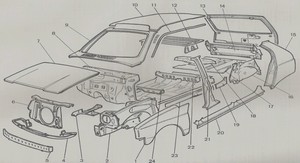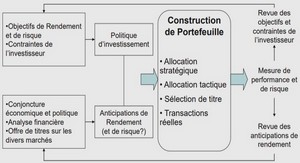Numerical methods for accurate and efficient ductile fracture predictions
An uncoupled fracture model for Advanced High Strength Steel sheets
We make use of a rate-independent simplification of the plasticity model proposed in Chapter 4. The onset of ductile farcture will be modeled independently using the so-called Modified Mohr-Coulomb (MMC) model (Bai and Wierzbicki, 2010, [7]). The predictive capabilities of the constitutive and fracture models described thereafter are not investigated here. The reader is referred to Mohr et al. (2010, [122]) and Dunand and Mohr (2011, [49]) for a critical evaluation.
Plasticity model
For the present sheet material, nearly the same stress-strain curve is measured for different specimen orientations even though the r-values are direction dependent. As 90 Chapter 5. Numerical methods for accurate and efficient ductile fracture predictions detailed in Mohr et al. (2010, [122]), we make use of a planar isotropic quadratic yield function, ( ) ̅ ̅ √( ) (5-1) in conjunction with a non-associated flow rule (5-2) denotes the plastic multiplier. The anisotropic quadratic flow potential reads √( ) (5-3) P and G are symmetric positive-semidefinite matrices, with ̅ and if and only if is a hydrostatic stress state. The values for the non-zero components of P and G are given in Table 5-1. denotes the Cauchy stress vector in material coordinates, [ ] (5-4) The components , and represent the true normal stress in the rolling, transverse and out-of-plane directions; denotes the corresponding in-plane shear stress, while and represent the corresponding out-of-plane shear stresses. Isotropic strain hardening is described as ( ̅ ) ̅ (5-5) where ( ̅ ) defines the strain hardening modulus. The strain hardening response of the material is modeled by a saturation law.
Fracture model
The original Mohr-Coulomb failure criterion (Mohr, 1900, [127]) is formulated in the stress space and assumes that failure occurs when the shear and normal stresses on any plane of normal vector n verify the condition.
Influence of Finite
Element modeling on ductile fracture predictions with the friction coefficient and the cohesion . Bai and Wierzbicki (2010, [7]) transformed Eq. (5-7) into the space of stress triaxiality, Lode angle and equivalent plastic strain to fracture assuming proportional monotonic loading, a pressure and Lode angle dependent isotropic plasticity model, and isotropic strain hardening according to the power law. The resulting explicit expression for the fracture strain reads . The exponent n describes the strain hardening of the material. The coefficient is related to in Eq. (5-7), while and characterize the dependence of the underlying plasticity model on the third stress invariant. controls the amount of Lode angle dependence of the fracture locus and ( ̅) controls the asymmetry of the fracture locus with respect to the plane ̅ . Despite the discontinuity of ( ̅), the fracture strain ̂( ̅) is a continuous function of the stress invariants and ̅. To apply the MMC fracture model for non-proportional loadings, Bai and Wierzbicki (2010, [7]) make use of Eq. (5-8) as reference strain in Eq. (2-19). 5.3 Influence of Finite Element modeling on ductile fracture predictions The influence of the type of elements (brick vs shell) and their characteristic dimensions are investigated on numerical simulations of a tensile experiment on a flat specimen with circular notches of radius 6.67mm, as sketched in Fig. 4-1c. Parameters for the constitutive model described in Section 5.2 have been calibrated on an extensive set of multi-axial fracture experiments carried out on TRIP780 steel (Mohr et al., 2010, [122]; Dunand and Mohr, 2011, [49]). Note that this material comes from a different production batch than the one used in Chapters 3, 4 and 6. Materials parameters are thus slightly different.




